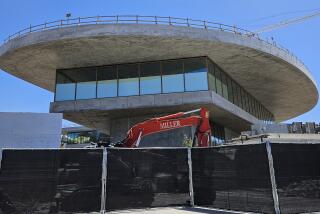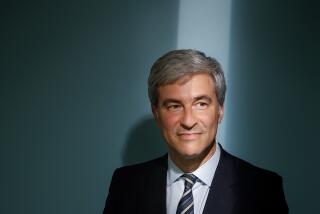ABOUT 300 WORKS : MORE PANZA ART MAY BE HEADED EAST
- Share via
Count Giuseppe Panza di Biumo’s art collection is on the move again. The Italian industrialist sold 80 Abstract Expressionist and Pop works to the Museum of Contemporary Art in 1984 and subsequently tantalized California museum directors with thoughts of acquiring a larger cache from his celebrated collection, but now he has set his sights on Massachusetts.
A Monday press conference confirmed early reports that about 300 mostly American works from the ‘60s and ‘70s may be placed on long-term loan to a museum that only exists on paper. Minimalist works and light/space installations by such artists as Robert Morris, Donald Judd, Carl Andre, Richard Serra, James Turrell, Richard Long, Dan Flavin, Sol LeWitt, Bruce Nauman and Robert Irwin would be moved from Panza’s villa in Varese and from storage in Italy to a museum in an old electric company.
The Massachusetts Museum of Contemporary Art and a sister institution, the Museum of Contemporary Architecture--already given the combined acronym MASS MoCA--are proposed as part of a mixed-use development of the Sprague Electric Co. complex in North Adams, Mass.
Sponsors say that $72 million is required to turn the soon-to-be-vacated plant into a museum, convention center and commercial complex in the decaying industrial town. About half that amount is being sought from the state.
Thomas Krens, director of the Williams College Museum of Art in nearby Williamstown, has masterminded the plan, with the blessing of Gov. Michael S. Dukakis. The museum, expected to occupy 435,000 square feet of a 750,000-square-foot complex, would be an independently owned, nonprofit institution operated by the Williams museum.
Panza did not attend the press conference and could not be reached in Italy. According to prepared statements, he has reached a “preliminary agreement” to fill about 180,000 square feet of the art museum with “a major part” of his collection, including the same Conceptual and Minimalist installations once courted by Los Angeles. Another long-term loan, models and drawings of contemporary architecture from the German Architecture Museum in Frankfurt, is planned for the architecture museum.
Although the ambitious concept has taken shape in an eight-volume proposal, financed by the Massachusetts State Office and Communities and Development and the Sprague Electric Co., Williams is still negotiating for the building with Penn Central and the request for state financing is currently before the Massachusetts legislature.
Panza’s commitment to the deal is contingent upon successful development of the property and his agreement is couched in tentative language that has a familiar ring to it.
“We talked to Panza. Now Williams is talking to Panza,” said Earl A. Powell, director of the County Museum of Art.
According to Powell, who worked with Richard Koshalek of the Los Angeles Museum of Contemporary Art and Hugh Davies of the La Jolla Museum of Contemporary Art to bring the collection to a coalition of museums in California, negotiations were serious and included substantive offers.
“We had gone a long way past preliminary discussions, to the point of making an offer to buy the works,” Powell said. “We negotiated in good faith” and offered specific plans for installing the art, he added.
One obstacle was that Panza wanted all the works to be shown together, requiring more space than any one local institution could manage. That problem can be surmounted at MASS MoCA if it comes to fruition.
Another impediment was that the Southern California museums wanted to be assured that they would ultimately own the works while Panza would only agree to long-term loans. A proposal to have the work appraised was never fulfilled and a price was never agreed upon.
Though Panza had made known his intention to sell the collection (at a rumored price of around $20 million), local museum directors feared that he might remove his collection after they had gone to great trouble and expense to house it. Cynics also speculated that Panza might be using the museum imprimatur to raise the value.
The Massachusetts proposal contains no mention of buying the collection or of Panza’s intent to donate it.
Panza originally planned to house his contemporary American collection in two castles near Turin, but the Italian government backed out when local artists opposed that use of the publicly owned buildings.
In 1985, when he began negotiating with Southern California institutions, Panza told The Times that he wanted to “delay any consideration of selling until 1990” and was looking for a place outside Italy to put it on long-term loan. Apparently the search continues.
More to Read
The biggest entertainment stories
Get our big stories about Hollywood, film, television, music, arts, culture and more right in your inbox as soon as they publish.
You may occasionally receive promotional content from the Los Angeles Times.










